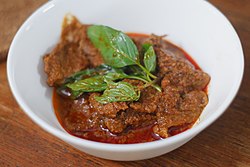Phanaeng: Difference between revisions
No edit summary |
|||
| Line 1: | Line 1: | ||
<languages /> | |||
<translate> | |||
{{Short description|Thick, salty, sweet red Thai curry paste}} | {{Short description|Thick, salty, sweet red Thai curry paste}} | ||
{{italictitle}} | {{italictitle}} | ||
| Line 21: | Line 23: | ||
'''''Phanaeng''''' ({{langx|th|[[wikt:พะแนง|พะแนง]]}}, {{IPA|th|pʰā.nɛ̄ːŋ|pron}}), also spelled '''''phanang''''', '''''panang''''', and other variants) is a type of red [[Thai curry]] that is thick, salty and sweet, with a zesty [[Kaffir lime|makrut lime]] flavour. The earliest known mention of ''phanaeng'' appears in Mom Somchin Rachanupraphan's book ''Tamra Kap Khao'' (ตำรากับข้าว), published in 1890. | '''''Phanaeng''''' ({{langx|th|[[wikt:พะแนง|พะแนง]]}}, {{IPA|th|pʰā.nɛ̄ːŋ|pron}}), also spelled '''''phanang''''', '''''panang''''', and other variants) is a type of red [[Thai curry]] that is thick, salty and sweet, with a zesty [[Kaffir lime|makrut lime]] flavour. The earliest known mention of ''phanaeng'' appears in Mom Somchin Rachanupraphan's book ''Tamra Kap Khao'' (ตำรากับข้าว), published in 1890. | ||
A popular ''phanaeng'' curry dish is pork ''phanaeng''. | A popular ''phanaeng'' curry dish is pork ''phanaeng''. In Thailand, this curry is usually eaten with [[rice]]. | ||
The etymology of the word ''phanaeng'' is unknown, but it may derive from the [[Malay language|Malay]] word ''[[wikt:panggang|panggang]]'', meaning "grilled." | The etymology of the word ''phanaeng'' is unknown, but it may derive from the [[Malay language|Malay]] word ''[[wikt:panggang|panggang]]'', meaning "grilled." | ||
| Line 38: | Line 40: | ||
[[Category:Food paste]] | [[Category:Food paste]] | ||
{{二次利用|date=24 March 2025, at 19:49}} | {{二次利用|date=24 March 2025, at 19:49}} | ||
</translate> | |||
Revision as of 09:32, 5 July 2025
 Pork phanaeng | |
| Alternative names | Panang, panaeng |
|---|---|
| Type | Curry |
| Place of origin | Thailand |
| Serving temperature | Hot |
| Main ingredients | Dried chili peppers, galangal, lemongrass, makrut lime zest, coriander root, coriander seeds, cumin seeds, garlic, shallot, shrimp paste, salt and peanuts |
Phanaeng (Thai: พะแนง, th), also spelled phanang, panang, and other variants) is a type of red Thai curry that is thick, salty and sweet, with a zesty makrut lime flavour. The earliest known mention of phanaeng appears in Mom Somchin Rachanupraphan's book Tamra Kap Khao (ตำรากับข้าว), published in 1890.
A popular phanaeng curry dish is pork phanaeng. In Thailand, this curry is usually eaten with rice.
The etymology of the word phanaeng is unknown, but it may derive from the Malay word panggang, meaning "grilled."
Phanaeng curry paste

The curry paste is made with dried chili peppers, galangal, lemongrass, makrut lime zest, coriander root, coriander seeds, cumin seeds, garlic, shallot, shrimp paste, salt and peanuts. The dish is usually made with meat cut into thin strips, makrut lime leaves, coconut milk, phanaeng curry paste, palm sugar and fish sauce. It typically contains thick coconut milk and has very little other liquid added.
| この記事は、クリエイティブ・コモンズ・表示・継承ライセンス3.0のもとで公表されたウィキペディアの項目Phanaeng(24 March 2025, at 19:49編集記事参照)を素材として二次利用しています。 Item:Q22554 |